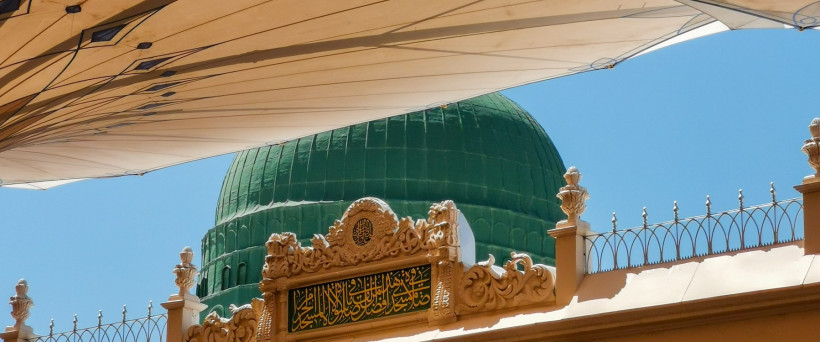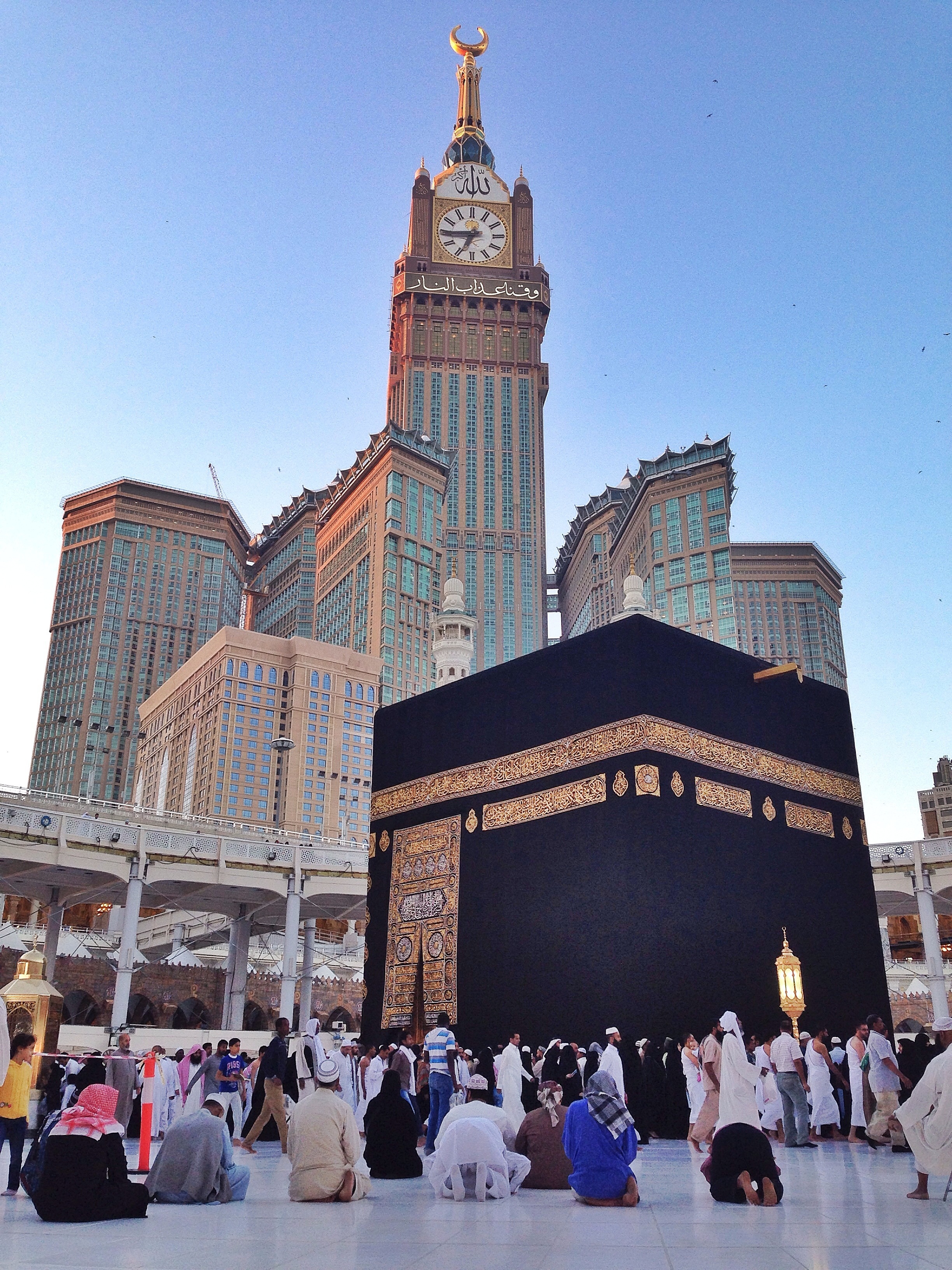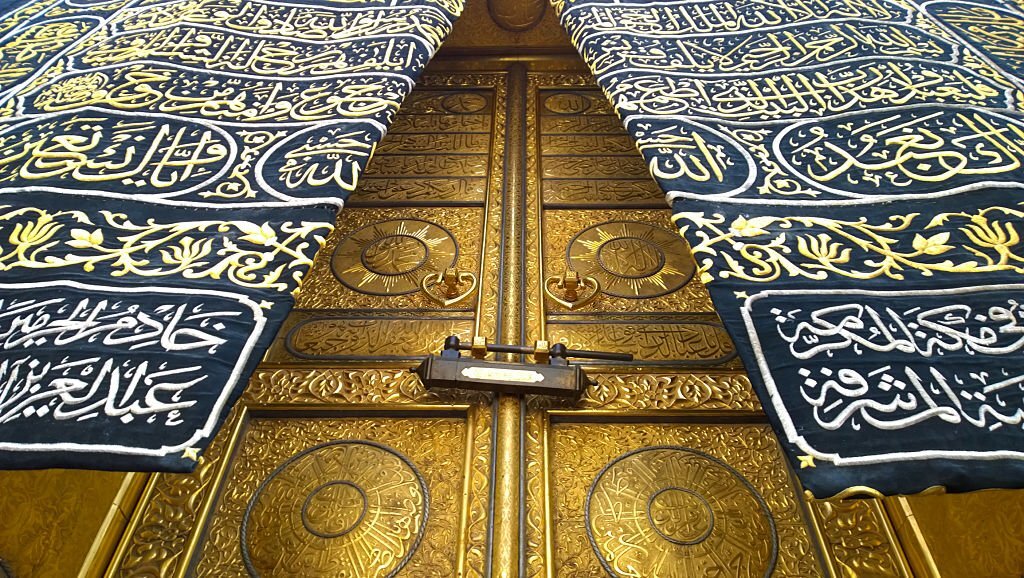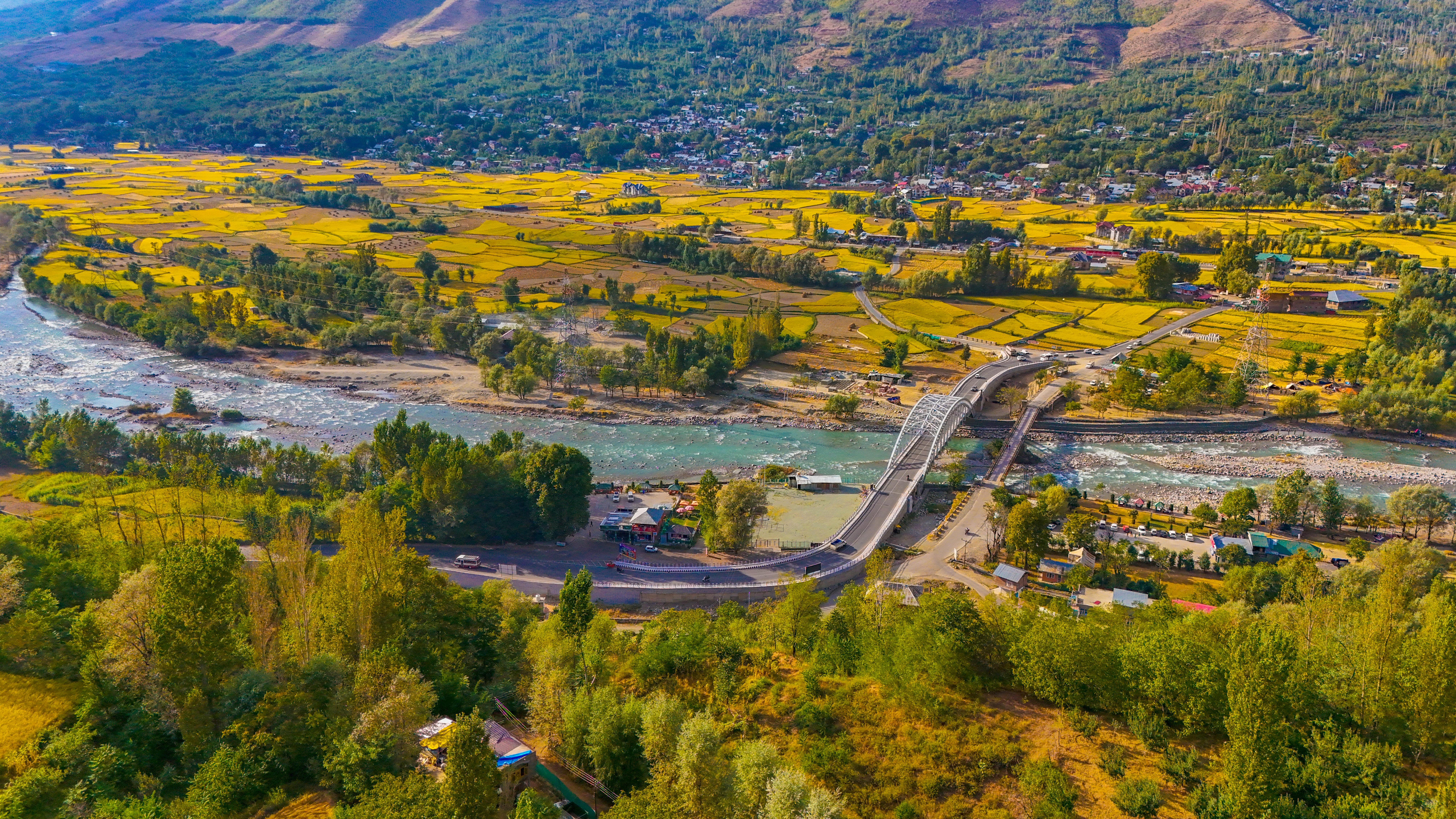Step 1: Wudhu
At the miqat (important boundaries for pilgrimage), before wearing Ihram garments, one is required to remove the hair below the navel and under the armpits as well as clip their nails. This should be followed by Ghusl, also known as Wudhu.
Step 2: Ihram
Ihram is a sacred state in which every pilgrim must enter before crossing the pilgrimage boundary, known as Mīqāt, both physically and spiritually. After making ghusl, use (alcohol free) perfume on body if available, and then put on the seamless two-piece garment of Ihram, which should be made of white cloth. This applies to men only.
Women should not use make up or perfume, and they may wear any clothes they have available, as long as they are loose fitting and do not display their adornments; women should be completely covered except for their face and hands.
Step 3: Salah al-Ihram
It is Sunnah to do two rakahs of Salah prior to entering the state of Ihram. One must make dua after the Salah is performed.
Step 3: Niyyah
The next step is declaring the intention or Niyyah for Umrah at or near the Miqat. One must declare Niyyah verbally and then reiterate it internally. Every pilgrim has to be clear about their intent (niyyah) whether for Umrah or Hajj before they start their journey.
Following are three examples of intentions that may be uttered in Arabic:
اﻟﻠﱠﮭم إ ِﻧّﻲ أُ ِر ْﯾدُ ا ْﻟﻌُﻣرةَ
Allāhumma innī urīdu l-‘umrata.
O Allah, I intend to perform Umrah.
اﻟﻠﱠﮭم إ ِﻧّﻲ أُ ِر ْﯾدُ ا ْﻟﻌُﻣرةَ ﻓَﯾَ ّﺳرھﺎ ﻟﻲ وﺗَﻘَﺑﱠ ْﻠﮭﺎ ﻣ ِﻧّﻲ
Allāhumma innī urīdu l-‘umrata fa yassirhā lī wa taqabbalhā minnī.
O Allah, I intend to perform Umrah, so accept it from me and make it easy for me.
Step 3: Talbiyah
After making your Niyyah, you must recite the Talbiyah to validate your intention and enter into the state of Ihram. The utterance of the Talbiyah is Wajib according to the Hanafi and Maliki schools of thought. The Shafi’i and Hanbali schools consider it a Sunnah.
The Sunnah method of reciting the Talbiyah is to briefly pause at four places, indicated by the dashes. The prayer is as follows:
لَبَّيْكَ اللّهُمَّ لَبَّيْكَ، لَبَّيْكَ لَا شَرِيكَ لَكَ لَبَّيْكَ، إِنَّ الْحَمْدَ وَالنِّعْمَةَ، لَكَ وَالْمُلْكَ، لَا شَرِيكَ لَكَ.
Labbayka llāhumma labbayk(a), labbayka lā sharīka laka labbayk(a), inna l-fiamda wa n-ni’mata, laka wa l- mulk(a), lā sharīka lak.
At Your service, Allah, at Your service. At Your service, You have no partner, at Your service. Truly all praise, favour and sovereignty are Yours. You have no partner.
It is recommended to send Salawat on the Prophet ﷺ after reciting the Talbiyah and to make Dua for yourself and others. Continue reciting the Talbiyah for the rest of your journey until you reach one of the doors of Masjid al-Haram prior to performing Tawaf.
Once Talbiyah has been said, one enters the state of Ihram and is called a Muhrim. After this point, if any prohibitions of Ihram are violated, Sadaqah or Damm (animal sacrifice as compensation) is required as expiation.
Step 4: Entering the Haram of Makkah
The Haram of Makkah is a sacred area that extends a number of miles around Masjid al-Haram in all directions. In this area, it is forbidden to:
- Cut or damage grass, trees or any other type of vegetation.
- Harm or kill wild animals. This includes scaring away pigeons and other birds.
- Carry weapons.
- Fight or behave in a way that will violate the sanctity of this area.
Although you’re unlikely to breach one of these rules, keep in mind the sanctity of Makkah.
As you reach the limits of the Haram, constantly recite the Talbiyah, do Dhikr and send Salawat upon the Prophet ﷺ. Recital of the following Dua is recommended upon entering the Haram:
اللَّهُمَّ هَذَا حَرَمُكَ وَأَمْنُكَ، فَحَرِّمْنِي عَلَى النَّارِ، وَأَمِّنِّي مِنْ عَذَابِكَ يَوْمَ تَبْعَثُ عِبَادَكَ، وَاجْعَلْنِي مِنْ أَوْلِيَائِكَ وَأَهْلِ طَاعَتِكَ.
Allāhumma hādhā fiaramuka wa amnuka fa fiarrimnī ‘ala-n-Nār, wa amminnī min ‘adhābika yawma tab’athu ‘ibādak, wa j‘alnī min awliyā’ika wa ahli ṭā’atik.
Allah, this is Your sanctuary and security, so make me unlawful to Hell-Fire, make me safe from Your punishment on the day You resurrect Your servants, and make me one of Your friends and one of the people who obey You.
Step 5: Entering Masjid al-Haram
It is Sunnah to enter Masjid al-Haram through Bab al-Salam, also known as the Gate of Peace. It is important to step through the gate with your right foot first and recite the supplication for entering Masjid al-Haram.
Either or both of these supplications may be recited:
بِسْمِ اللَّهِ، اللَّهُمَّ صَلِّ عَلَى مُحَمَّدٍ. اللَّهُمَّ اغْفِرْ لِي وَافْتَحْ لِي أَبْوَابَ رَحْمَتِكَ.
Bismi-llāh, Allāhumma ṣalli alā Muhammad. Allāhumma-ghfir lī wa-ftafi lī abwāba rafimatik.
In the name of Allah, send blessings upon Muhammad ﷺ. O Allah, open for me the doors of Your Bounty.
أَعُوذُ بِاللَّهِ الْعَظِيمِ، وَبِوَجْهِهِ الْكَرِيمِ، وَسُلْطَانِهِ الْقَدِيمِ، مِنَ الشَّيْطَانِ الرَّجِيمِ.
A‘ūdhu bi-llāhi-l-Aẓīm, wa bi-wajhihi-l-karīm, wa sulṭānihi-l-qadīm, mina-sh-Shayṭāni-r-rajīm.
I seek protection in Allah the Tremendous, His Noble Countenance, and His pre-eternal Sovereign Might from Shaytan the rejected.
Step 6: First Sight of the Kaaba
After entering the mosque, keep your gaze lowered until you reach the Mataf area, which is the open space where Tawaf takes place. When you’re ready, with humility, awe and reverence, lift your gaze to set sight on the beatific vision of the Holy Kaaba.
Upon seeing the Kaaba for the first time, raise your hands and make Dua with the utmost concentration and sincerity as this is among those places where prayers are answered. Remember to recite Salawat upon the Prophet ﷺ when making Dua.
Do Dhikr, make Dua and send Salawat upon the Prophet ﷺ in abundance here. Make the most of this opportunity before you begin your Tawaf, especially if it’s the first time you’ve set eyes on the Kaaba.
Step 7: Tawaf al-Umrah
- Preparation:
Ensure you’re in a state of Wudhu and if you’re a male, uncover your right shoulder by passing the top sheet of your Ihram under your right armpit, allowing the garment to hang over your left shoulder (Idtiba) .
- Starting Point:
Position yourself in line with the corner of the Kaaba where the Hajar al-Aswad is situated. This corner is the one that faces a single minaret (the other three corners face two minarets). There is a green light on the wall of the Masjid opposite the Kaaba which indicates where the Tawaf starts
from. This is the starting point of each Shawt (circuit). Stand just before this starting point facing the Kaaba ensuring the Hajar al-Aswad is on your right side.
Hijr Ismail
Yemeni corner
Black Stone
Maqam Ibrahim
Al-Safa
- Intention
As with any other act of worship, make the Niyyah to perform Tawaf solely for Allah. You may also ask for acceptance and ease of your Tawaf. The following words may be said:
O Allah, I intend to perform the Tawaf of Umrah of the Kaaba for your sake and your sake alone. Please accept it from me and make it easy for me.
You may make the following intention, which is in Arabic:
اللَّهُمَّ إِنِّي أُرِيدُ الطَّوَافَ بِبَيْتِكَ الْحَرَامِ فَيَسِّرْهُ لِي وَتَقَبَّلْهُ مِنِّي.
Allāhumma innī urīdu l-ṭawwafa baytika l-fiarāmi fa yassirhu lī wa taqabbalhu minnī.
O Allah, I intend to perform Tawaf of the Sacred Mosque, so accept it from me and make it easy for me.
- Kissing, Touching or Saluting the Hajar al-Aswad (Istilam)
- Kissing – If you reach the Hajar al-Aswad, place your hands on it, put your face between your
hands, say “bismi llāhi wallāhu akbar (بِسْمِ اللَّهِ وَاللَّهُ أَكْبَرُ.)” and kiss it lightly. Some
scholars have said it is preferable to kiss it three times if you have the chance.
- Touching – If you’re in reaching distance but unable to kiss it, touch it with your hand(s) and kiss your hand(s).
• Saluting – If it isn’t possible to reach the stone, as is likely to be the case, perform a symbolic Istilam from afar by directly facing the Hajar al-Aswad and raising your hands up to your earlobes (as you would do when starting Salah). Ensure your palms are also facing it, as though your face and hands are on the Hajar al-Aswad and say “bismi llāhi wallāhu
akbar (بِسْمِ اللَّهِ وَاللَّهُ أَكْبَرُ.).” You may kiss your palms if you wish.
- Start of Tawaf:
Turn to your right and start the first circuit of your Tawaf, ensuring the Kaaba is on your left. Proceed in an anti-clockwise direction and avoid walking through the Hijr Ismail. If you happen to walk through it, the circuit won’t count and it will have to be repeated.
In the first three circuits, men should perform Raml, which is the practice of walking briskly.
During your Tawaf, you may recite prayers and supplications of your choice. Duas are accepted during Tawaf so make the most of the occasion and remember Allah with sincerity and devotion. It’s perhaps advisable not to read from a Dua book, especially if you don’t understand the Arabic. Imam Ibn Hibban (rahimahullah) said:
Specifying a Dua would take the moment away, because with specific Duas, one will merely be repeating words, whereas this occasion is for any Dua and for remembering one’s Lord with humility and sincerity.
Thus, you should supplicate in any language and in any manner that you prefer. If you want to make Quranic and Prophetic supplications during your Tawaf, make an effort to memorise and learn the meanings of them. Reciting Quran and sending Salawat upon the Prophet ﷺ during Tawaf is also recommended.
Returning to Hajar al-Aswad marks the completion of one circuit. Begin the second by doing Istilam of Hajar al-Aswad as previously described and saying “Allāhu akbar (ُاللَّهُ أَكْبَرُ.)”. You should say Allāhu akbar while doing Istilam in all subsequent circuits. You will be performing Istilam eight times in total during the Tawaf; one before the start of the Tawaf and one at the end of each of the seven circuits.
- : Complete the Tawaf
Proceed in the same manner until have you completed seven circuits. Performing Istilam at the start of Tawaf and at the end is a highly emphasised Sunnah and performing Istilam on the other six occasions is desirable.
If you are in a state Idtiba, cover your shoulder with your Ihram.
NOTE: The Tawaf should be completed in a continuous manner with no interruptions between circuits. However, if a congregational prayer is due to start, you must join the congregation and resume your Tawaf from the position that you stopped. The circuit need not be repeated. These rules also apply if you need to repeat your Wudhu.
- : Salah
Upon finishing the Tawaf, perform two Rakahs of Salah, preferably in a position where Maqam Ibrahim is between you and the Kaaba.
NOTE: It is Sunnah to recite Surah al-Kafirun (Surah 109) in the first Rakah and Surah al-Ikhlas (Surah 112) in the second, after Surah al-Fatiha. Make sure you make plenty of Dua after completing the prayer.
Step 8: Drink Zam Zam:
After completing Salah and making Dua, drink your fill of Zamzam water which is available around the Tawaf area and from various water fountains and dispensers in Masjid al-Haram.
When drinking the water, it is Mustahabb to should stand and face the Kaaba, say Bismillah, pause to take a breath three times, and say Alhamdulillah after finishing. You can also rub it on your face and body. You may recite the following Dua after drinking the water:
اللَّهُمَّ إِنِّي أَسْأَلُكَ عِلْمًا نَافِعًا، وَرِزْقًا وَاسِعًا، وَعَمَلًا مُتَقَبَّلًا، وَشِفَاءً مِنْ كُلِّ دَاءٍ.
Allahumma innī as’aluka ‘ilman nāfi’an, wa rizqan wāsi’an, wa ‘amalan mutaqabbalan, wa shifā’an min kulli dā’.
O Allah, I ask You for knowledge that is beneficial, provision that is abundant and a cure from every illness.
Step 9: Multazam
After you have finished drinking Zamzam water, you may proceed to the Multazam which is the area between Hajar al-Aswad and the door of the Kaaba.
If it is possible to reach the Multazam, raise your hands above your head, cling to the wall and press your chest and cheeks against it. It is a Sunnah of the Prophet ﷺ and yet another station where supplications are accepted, so you should lengthen your Dua here.
If you can’t reach the Multazam due to the crowds, you may face it and supplicate from a distance.
Before Sa’i, it is Sunnah to do Istilam of Hajar al-Aswad one last time. This will be the ninth time, following the eight times you performed Istilam during Tawaf. If you’ve forgotten to perform this Istilam, or you’re finding it difficult to return to the line of the Hajar al-Aswad due to crowding or tiredness, it may be omitted. However, you can do Istilam anywhere else in Masjid al-Haram, as long as you’re facing the Hajar al-Aswad.
Step 10: Sa’i
It is a Sunnah to perform Sa’i immediately after Tawaf, although you may take a break if you need to. If you feel tired after Tawaf or your feet are aching, you may take a rest until you feel you’re ready. Remember, you will be covering over three kilometres during Sa’i, so make sure you have sufficient energy to complete the rite before starting.
1. At Safa
Proceed to the hill of Safa, which is located inside Masjid al-Haram in line with the Hajar al-Aswad. There are signs which indicate where it is. As you’re approaching Safa, it is Sunnah to recite the following:
إِنَّ الصَّفَا وَالْمَرْوَةَ مِنْ شَعَائِرِ اللَّهِ.
Inna ṣ-ṣafā wa l-marwata min sha’ā’iri llāh(i).
Indeed, Safa and Marwa are from the Signs of Allah. [Surah al-Baqarah, 2:158]
Then say:
أَبْدَأُ بِمَا بَدَأَ اللَّهُ بِهِ.
Abda’u bimā bad’allahu bihi.
I begin with that which Allah has begun with.
These should only be recited once before Sa’i and not at the start of each lap.
- Make Dua at Safa
Upon reaching the hill of Safa, face the direction of the Kaaba and raise your hands in supplication. Your view of the Kaaba may be obscured so make an educated guess about its location and face this direction. You may say Takbir (Allāhu akbar), Tahlil (lā ilāha illā Allāh) and send Salawat upon the Prophet ﷺ.
- Proceed to Marwa
From Safa, make your way towards Marwa. Between Safa and Marwa, you will encounter two sets of green fluorescent lights approximately 50 metres apart, which indicate the distance that Hajar ran in order to get to higher ground. These two markers are known as Milayn al-Akhdharayn (the two green mileposts). Between these two lights, it is Sunnah for men to run at a medium pace while women should continue normally.
Dhikr & Dua During Sa’i: There is no fixed Dhikr or Dua that has been prescribed to be read during Sa’i, so you may recite any prayers or supplications of your choice and send Salawat upon the Prophet ﷺ.
- Make Dua at Marwa
Upon reaching the hill of Marwa, face the direction of the Kaaba, raise your hands in supplication and repeat the same supplications you recited at Safa.
This completes one lap of Sa’i. Returning back to Safa is considered a second lap.
- End of Sa’i
Repeat this procedure until you have completed seven laps, at which point you should be at the hill of Marwa.
6. :Dua & Salah
It is recommended to make a final Dua here and also to perform two Rakahs of Nafl Salah in Masjid al-Haram following Sa’i.
- Leave the Haram
As you leave Masjid al-Haram, step out with your left foot and recite the following Dua, as was the Sunnah of the Prophet ﷺ when leaving the mosque:
بِسْمِ اللَّهِ، وَالصَّلَاةُ وَالسَّلَامُ عَلَى رَسُولِ اللَّهِ. اللَّهُمَّ إِنِّي أَسْأَلُكَ مِنْ فَضْلِكَ.
Bismi llāhi, wa ṣ-ṣalātu wa s-salāmu ‘ala rasūli llāh. Allāhumma innī as’aluka min faḍlik.
In the name of Allah, and peace and blessings be upon the Messenger of Allah. O Allah, I ask of you from Your bounty.
Step 11: Halq or Taqsir
After Sa’i, you must have your hair shaved (Halq) or trimmed by at least an inch (Taqsir) in order to leave the state of Ihram and complete your Umrah. It is more virtuous for a man to have his head shaved completely.
Women may only have their hair trimmed.
You are now free from the restrictions of Ihram and you may change into regular clothing. If you plan on performing another Umrah, you must travel to the boundary of the Haram in order to once again enter into Ihram. Most pilgrims choose to enter into Ihram at Masjid Aisha which is the nearest and most convenient location from Masjid al-Haram. Taxis are available near the mosque.
Performing Umrah is believed to offer tremendous blessings and benefits. Although there is no specific time for it, Umrah during Ramadan is considered very virtuous.









Showing verified guest comments
No reviews yet. Be the first to leave a review!